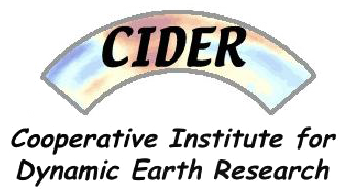CIDER 2023 Summer Program - Causes and consequences of fluid and magma transport at plate boundaries
The CIDER 2023 summer program is funded by the NSF GeoPRISMS program to explore the causes and consequences of fluid and magma transport at plate boundaries. Lectures and tutorials are organized around three research themes: (1) role of aqueous fluid on fault interfaces at subduction zones and ridges; (2) magma production rates and tectonic interactions at subduction zones and ridges; (3) magma transport from the source to the crust. The goal is to synthesize past scientific results and to look forward to future research initiatives.
About CIDER
- Visit the News Page for latest news and deadlines, as well as CIDER wiki page for general CIDER announcements, and materials assembled since 2004, including lecture collection.
- CIDER is currently supported by the National Science Foundation through CSEDI Program (EAR-1903727) and the GeoPRISMS Program (OCE-2025195). Prior support through the Frontiers of Earth Systems Dynamics (FESD) was under grant number EAR-1135452. Please acknowledge the CIDER Program and the relevant grant in any publication resulting from or inspired by CIDER.
- Browse through the CIDER lecture collection from 2004 to present.
The goals of the Cooperative Institute for Dynamic EarthResearch are: (1) To provide an optimal environment for transformative studies requiring a concerted effort of leading researchers from different areas of Earth Sciences: high pressure material science, geodynamics, seismology, geochemistry and geomagnetism, and (2) to educate a new generation of Earth scientists with breadth of competence across the disciplines contributing to understanding of the deep earth. The ultimate goal of CIDER is to develop an integrative conceptual model drawing upon all contributing disciplines to understand the origin, evolution, and dynamics of the Earth and, by extension, other planets. The practical objectives are to:
- Address the most important and difficult problems that have defied solution thus far by fostering collaborations that can fully utilize existing knowledge and technology.
- Provide a seed-bed for ideas that will identify the next generation of critical experiments and observations, and build support and appreciation for them.
- Provide a venue for cross-disciplinary education of scientists at all career levels, and in particular, educate a new generation of Earth scientists with a breadth of competence across disciplines.

